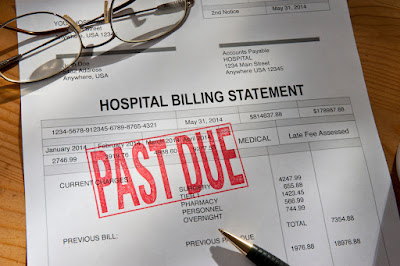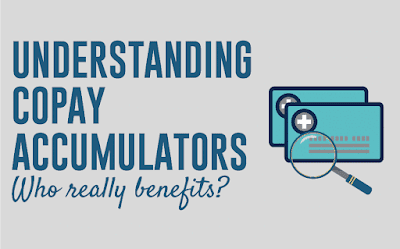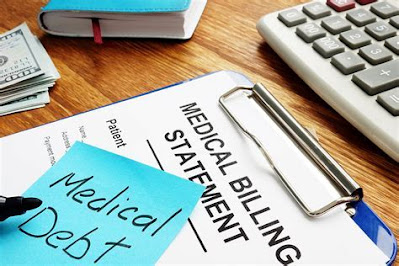By: Ranier Simons, ADAP Blog Guest Contributor
In the United States, healthcare is one universal expense incurred by everyone, regardless of their station in life. Approximately 100 million people in this country, including 41% of adults, have some sort of medical debt.[1] Some people can manage it, but many struggle. As a result of medical debt, people have had to cut spending on food and necessities, deplete savings, delay purchasing a home, work multiple jobs, or even declare bankruptcy.[1]
 |
| Photo Source: iStock (purchased) |
Most of the medical debt is actually hospital debt, and that debt is owed to large hospitals, not small private practices. In the United States, there are two different types of hospitals: for-profit and nonprofit. There are 5,139 community hospitals, with 1,228 being for-profit, 951 being state and local government-run hospitals, and 2,960 being non-governmental nonprofit health facilities.[2] For-profit hospitals are business-oriented and owned by investors and shareholders; thus, they are focused on making money for their stakeholders. Nonprofit hospitals are not beholden to any shareholders or investors. In theory, their profits are to be reinvested into the hospitals for their operations. Additionally, nonprofit hospitals are tax-exempt and required to provide more community health services and serve patients regardless of whether they can afford care. Unfortunately, some nonprofit hospitals are the worst offenders when it comes to saddling patients with debt.
Nonprofit hospitals do not pay any federal and state income, property, or sales taxes and receive other tax breaks.[2] In 2020, the nation’s nonprofit hospitals received an estimated $28 billion in tax benefits, accounting for 44% of their net income.[3] In return for the tax benefits, the federal government requires nonprofit hospitals to provide community benefits such as charity care. Charity care is providing services to low-income people for free or at significantly reduced rates.[3] The Affordable Care Act (ACA) also mandates that they must maintain a transparent and available financial assistance program and refrain from taking “extraordinary collection actions” against patients eligible for charity care.[4] The reality of some of the largest nonprofit hospitals is a travesty of the concept of charity care.
 |
| Photo Source: National Nurses United |
Some nonprofit hospitals aggressively pursue patients over their bills. They garnish paychecks and sell patient accounts to collection agencies (debt buyers) that harass and intimidate. Lawsuits are filed against patients for outstanding balances. Some of them are filed against people who qualify for charity care. These lawsuits attach legal fees and late payment interest, multiplying the original outstanding debt amounts. Moreover, some hospitals pursue family members for a patient’s medical debts and even place property liens on patients’ homes. Many do not find out about property liens until a relative has passed. Property liens lower the value of homes and adversely affect the transference of intergenerational wealth.
Federal tax law mandates that nonprofit hospitals spend some of their revenues as community benefit and defines the kind of spending that qualifies but does not stipulate the amount. Charity care is just one of the defined categories of spend. In 2020, nonprofit hospitals had approximately $28 billion in tax exemptions but provided only $16 billion in free or discounted services through charity care.[5]
U.S. Senator Bernie Sanders, chair of the Senate Committee on Health, Education, Labor & Pensions (HELP), filed a congressional report on nonprofit hospitals and their tax exemptions. The committee examined 16 of the largest nonprofit health systems in the U.S., finding that they spent less than 60% of the estimated value of their tax breaks on charity care.[6] The 16 hospital chains examined took in more than 3$ billion in annual revenue. Twelve of the 16 chains dedicated less than two percent of their total revenue to charity care, with 6 of those 12 having less than 1% of their total revenue dedicated to charity care.[3] Between 2012 and 2019, nonprofit hospitals increased their average operating profit by more than 36% and almost doubled their cash reserves. In the same timeframe, charity care spending dropped from only $6.7 million to $6.4 million.[3] Ironically, in 2021, of the 16 nonprofit hospital chains in the report, the average CEO compensation was $8 million, with a collective total of more than $140 million.[3]
 |
| Photo Source: WRAL |
Sen. Sanders feels that Congress should specifically define the level of charity care and financial assistance required of nonprofit hospitals. One suggestion is that tax breaks be limited to the amount of charity care provided. Additionally, Sanders feels that hospital financial assistance programs should have defined standards. For example, some of the hospitals do not transparently explain, advertise, or actively facilitate entering qualified patients into the programs. Instead, some hospital systems, such as Atrium in North Carolina, steer patients towards loans to pay their outstanding bills that sometimes have interest rates as high as 13%.[7]
Hospital groups pushed back against the analyses by Sen. Sanders, but they also tend to oppose any accountability or transparency reforms.. The American Hospital Association states that nonprofit hospitals' community benefit is comprehensive and encompasses more than just charity care. It says that community benefit includes research, medical innovation, absorbing underpayments from Medicaid, health education, and housing assistance.[6,8] That sentiment is misleading and flawed. For example, a good deal of research is funded by taxpayers’ dollars.
Jen Laws, President & CEO of the Community Access National Network (CANN), isn't buying the AHA's argument. According to Laws, financial assistance and community benefit are different line items on the Internal Revenue Service's Form 990 for a reason. In fact, CANN has been quite vocal on the need for reforms to programs designed to help indigent patients, yet are falling short of that intended goal.
According to Laws, community assumption is a "good faith" definition, but loopholes surrounding hospital-related nonprofit status tax rules inevitably can lead to bad faith in this space, or even abuse. He believes the overwhelming body of evidence surrounding the decline in hospital charity care is in direct opposition of the IRS' intention, namely providing a benefit to needy persons, families, and communities.
Laws said, "For example, our government, namely the IRS, hasn't updated 'community benefit' rules in decades and many no longer apply, like having an open Emergency Room. This gets to the core of CANN's position - honesty is not part of that muddy language. And we need to be frank about that lack of honesty."
It is crucial that community benefit standards are revamped with a focus on charity care that directly benefits those in need. In some states, the difference between the amount of funds spent on charity care and the total tax exemptions the nonprofit hospitals receive is greater than the recorded debts listed on patients' credit reports.[3] Change must come so that needy patients' lives are no longer ruined by being sued by hospitals for outstanding balances as low as $500 or less that they can’t afford to pay.
[1] Levey,N. (2022, June 16). 100 Million people in America are saddled with health care debt. Retrieved from https://kffhealthnews.org/news/article/diagnosis-debt-investigation-100-million-americans-hidden-medical-debt/
[2] Modi, J. (2023, March 21). Nonprofit vs. for-profit hospitals: what’s the difference? Retrieved from https://www.buzzrx.com/blog/nonprofit-vs-for-profit-hospitals-whats-the-difference
[3] United States Senate Health, Education, Labor, and Pensions Committee. (2023, October 10). Mahority Staff Report: Major Nonprofit Hospitals Take Advantage of Tax Breaks and Prioritize CEO Pay Over Helping Patients Afford Medical Care. Retrieved from https://www.sanders.senate.gov/wp-content/uploads/Executive-Charity-HELP-Committee-Majority-Staff-Report-Final.pdf
[4] 26 U.S.C 501(r)(4), (6); Internal Revenue Serv, Billing and Collections – Section 501(r)(6) (Jul. 13, 2023), https://www.irs.gov/charities-non-profits/billing-and-collections-section-501r6.
[5] Miller, A., Hawryluk,M. (2023, July 11). As Nonprofit hospitals reap big tax breaks, states scrutinize their required charity spending. Retrieved from https://kffhealthnews.org/news/article/nonprofit-hospitals-tax-breaks-community-benefit/
[6] Wilkerson,J. (2023, October 10). Bernie Sanders bashes nonprofit hospitals over their tax breaks. Retrieved from https://www.statnews.com/2023/10/10/bernie-sanders-nonprofit-hospitals/
[7] Levey,N. (2023, August 16). North Carolina hospitals have sued thousands of their patients, a new report finds. Retrieved from https://kffhealthnews.org/news/article/north-carolina-hospitals-patient-debt-lawsuits/
[8] American Hospital Association. (2023, October). Tax-exempt hospitals provided nearly $130 billion in total benefits to their communities. Retrieved from https://www.aha.org/system/files/media/file/2023/10/Results-from-2020-Tax-Exempt-Hospitals-Schedule-H-Community-Benefit-Reports.pdf









